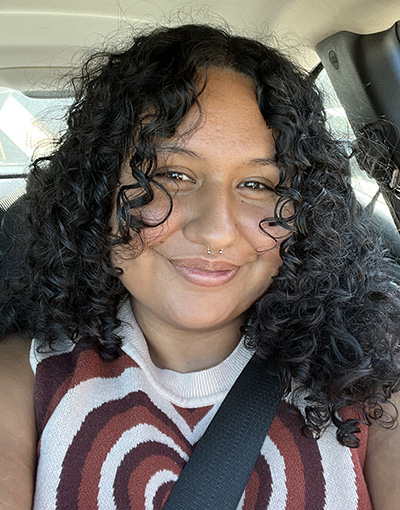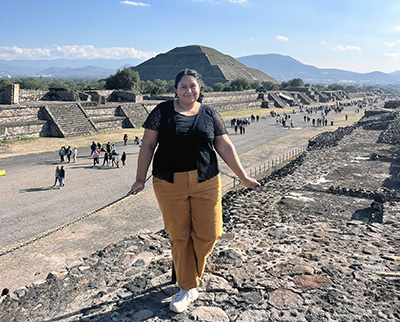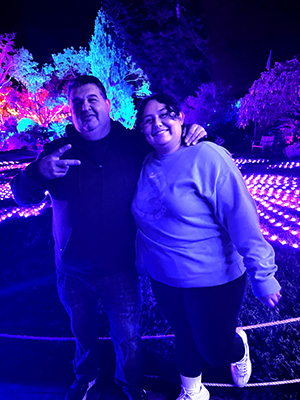Student Spotlight: Karla Rojas Garcia
January 17, 2024 | By Michelle Franklin
PhD student Karla Rojas Garcia is studying analytical and atmospheric chemistry in Distinguished Professor of Chemistry and Biochemistry Vicki Grassian’s lab. As a graduate of UC Irvine, Karla’s Southern California roots have shaped her academic career in her fight for environmental justice. Learn more about her studies and how she hopes to make a difference in some of San Diego’s most polluted communities.
 Q: Why did you choose UC San Diego?
Q: Why did you choose UC San Diego?
Karla Rojas Garcia: I’m from San Diego. I was raised in Barrio Logan and that’s where I live now. My parents are immigrants from Mexico and eventually they'll go back. Because of that, I wanted to be closer to the border, and I also wanted to spend as much time with them as I can now. My mom is from Jalisco and my dad is from the Tijuana area.
Q: How did you first become interested in chemistry?
KRG: I first became interested in chemistry in high school because I noticed you couldn’t really explain any natural phenomena without chemistry. My physics class, biology class, environmental science class — they all required chemistry. I wanted to be someone who could explain why things happen down to the building blocks.
Q: Was there a certain kind of chemistry that really appealed to you?
KRG: It wasn't until my junior year of college that I started to become interested in atmospheric chemistry. I read a research paper that talked about asthma cases being really high in communities that suffer from environmental injustice and racism. That was the first time I had ever heard that term.
Barrio Logan is one of those communities that suffers from environmental racism. I learned that because of our social class and race, we’re bearing the burden of the environmental pollution in San Diego, in California, and even the United States. Barrio Logan is one of the most polluted neighborhoods in the state.
That was my big moment. I knew I needed to study atmospheric chemistry so I can do something to change this situation.
Q: Can you explain what environmental injustice and racism are?
KRG: Let's talk about San Diego. If you look at each neighborhood demographically, you'll notice there is a segregation of race and class. Places like Barrio Logan, City Heights and National City primarily have lower class working people that are Black, Hispanic or Southeast Asian. Those three neighborhoods are the epicenters for factories, military bases and warehouses.
On the other hand, neighborhoods like La Jolla, Del Mar and Point Loma are middle-to-high-class neighborhoods. They're primarily populated by white people. You won’t find factories, power plants or warehouse in these neighborhoods. It becomes an obvious distinction that People of Color, people with lower incomes tend to live in areas that are targeted by manufacturing companies, utilities, the military.

Q: How can atmospheric chemistry support environmental justice?
KRG: Environmental policy regulates a lot of what goes on in these neighborhoods — which companies get to build factories or warehouses here; how many can exist within a certain radius or distance from residential houses — and I really feel like you need an atmospheric scientist advising on these policies. You can't talk about protecting these neighborhoods from atmospheric pollution without being able to measure these pollutants. You need scientific experts to guide policy.
Q: Can you tell us about your NSF Graduate Research Fellowship Grant?
KRG: I’m studying how wildfires are essentially accelerating the production of this specific molecule called nitrous acid (HONO). I'm trying to see which gases and particles that come from wildfire smoke can make more HONO and nitrogen dioxide.
I’m interested in HONO for two reasons. First, by itself nitrous acid is a pollutant that is dangerous for human respiration. It can cause cardiovascular and respiratory diseases when inhaled at high levels. Even though this molecule has been studied for many years, the way it's formed is still unknown. Its full life cycle is not understood fully yet.
The second reason is that it's a precursor to hydroxyl radicals. In atmospheric chemistry we know that hydroxyl radicals are one of the most potent oxidizers in the atmosphere. They can make even more dangerous pollutants like ozone or nitrogen dioxide. So HONO by itself is a pollutant, but it can also kickstart the formation of even more pollutants.

at Lightscape San Diego.
Q: Who is someone who has had an impact on you?
KRG: I would say my father. He immigrated from Mexico when he was very young, and his only goal was to provide for his family. He came here with nothing, but he has given me a really full life. Through my father I've learned the meaning of resilience, perseverance and self-sustenance. There were a lot of times in my academic career when I wanted to quit because I felt different from everyone else. I would look around and see that I was the only Brown person in the room. That really affected my morale and my confidence. But remembering my dad and how hard he worked to get me to this point helped me keep going. His story of how he had all these barriers and still overcame them made me feel like I have all these barriers, but I can overcome them too.
Q: What challenges have you had to overcome as a minority in STEM?
KRG: Some of the barriers I've faced have come from external factors because of the history of racism and sexism, not just in the country, but in academia. But I will say I'm fortunate enough to never have really encountered any discrimination in my academic career firsthand. A lot of the barriers have come from my own self-image.
It has taken many years to start believing in myself and to feel like I actually belong. For years. I attributed my successes to luck — not because I deserved it, not because I was intelligent. I don't think it was until I joined a lab at UC Irvine under my research advisor, Ann Marie Carlton, when I finally started to build some of that confidence, and I could see how my research could make an impact.
Q: What’s your favorite spot on campus?
KRG: It has to be Pinpoint Cafe at Scripps Institution of Oceanography because of the beach view. I like to get their mocha. It's really good and strong too.
Q: What are you into right now?
KRG: I love to read. Right now, I'm reading Mistborn by Brandon Sanderson. And I'm watching The Witcher on Netflix. I love a good fantasy world and The Witcher world is enticing and unique.
